Obesity Rates & Facts By State
Health Reporter dives into the crisis that is sweeping across America – obesity.

Figures show that it is worse than ever before, with every US state now having an obesity rate above 20%. This is even more shocking given that no state had rates over 15% just 20 years ago – so what is causing this?
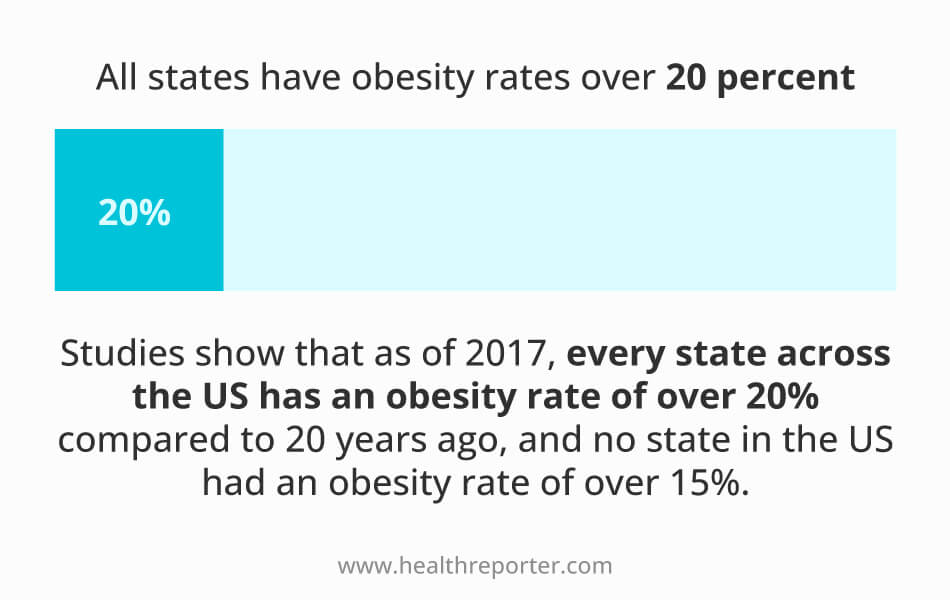
There is a common stereotype about America, and it’s mostly about weight.
We wanted to see if these claims were valid by looking at America’s long-standing battle with weight and obesity.
Did you know?
Health Reporter reminds that, according to WHO, a “normal” BMI sits between 18.5 and 24.9. 25.0 to 29.9 is considered overweight or pre-obesity. People with a BMI over 30 are obese.
Adult obesity rates now exceed 35 percent in 16 states, according to the latest 2021 data from the Behavioral Risk Factor Surveillance System (BRFSS). Mississippi had the highest adult obesity rate at 39.7 percent, and Colorado had the lowest at 24.2 percent.
Adult obesity rates rose in Alabama, California, and Iowa between 2019 and 2020. Adult obesity rates have increased significantly in 26 states since 2015.
How common is obesity?
On average, one in three adults is obese, or about 36% of the population.
The age-adjusted prevalence of obesity in adults in 2017-2018 was 42.4%.
By 2030, an estimated 20% of the global population will be obese.

In the United States, approximately 18.5 percent of children between the ages of 2 and 19 are considered obese.

Obesity prevalence in the United States climbed from 30 percent to 41 percent from 1999 to 2020. Simultaneously, extreme obesity increased from 4.8 percent to 9.3 percent.
Obesity is closely linked to other medical conditions, such as heart disease and strokes. There are also links to obesity, cancer, and type 2 diabetes.
In 2019, the annual medical cost of obesity in the United States was expected to reach approximately $172 billion. Adults with obesity had medical costs roughly $1,860 more than those with a healthy weight.

8 Obesity Facts – USA
1. More than one-third of adults in the United States suffer from obesity
In the US, over 35% of adults suffer from obesity, whereas another 32.5% are overweight. Over two-thirds of adults in the US are overweight or suffer from obesity.
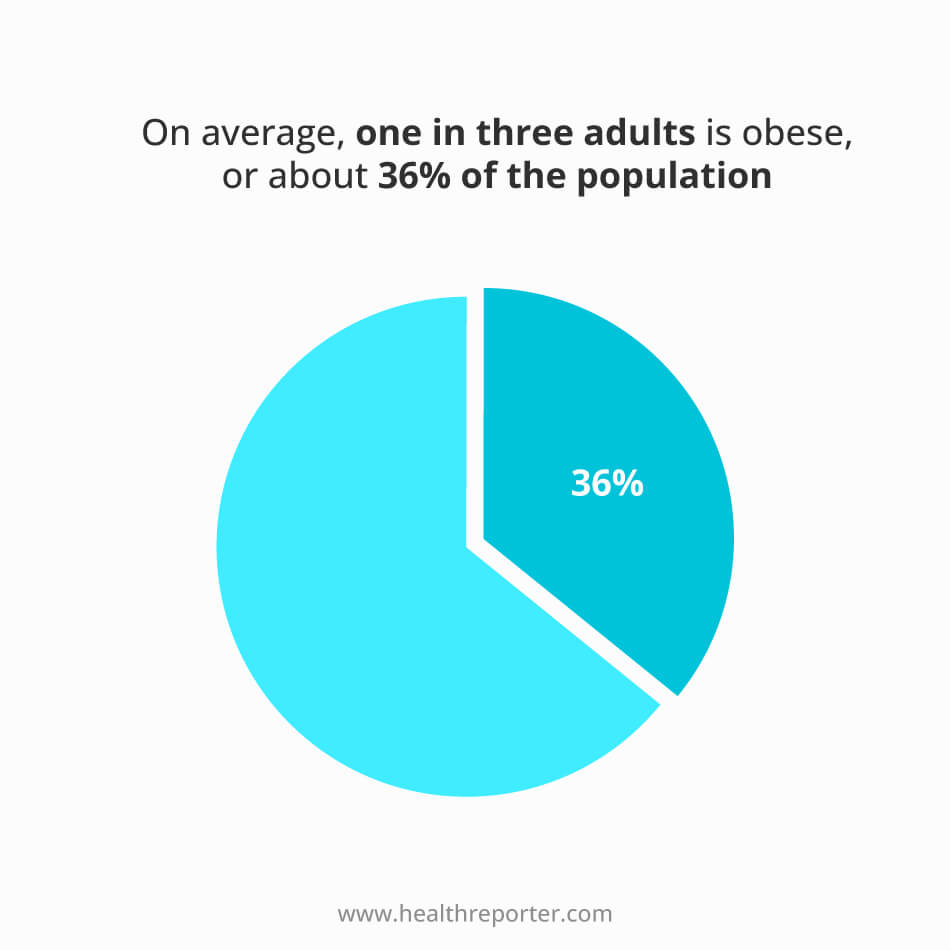
2. Obesity affects 1 in 6 children in the United States
Roughly 17% of American kids aged 2 to 19 have obesity – more than 12.5 million. One in eight preschool children has obesity – although this rate has been falling recently.
3. Americans are eating more calories than ever before
Americans eat over 20% more calories than they did in 1970.
4. Overweight children are more likely to become overweight adults
Children who suffer from obesity are five times more likely to carry this into adulthood, increasing their chances of further health complications.
5. Obesity causes more deaths than being underweight
Obesity is one of the top five causes of death worldwide – it causes more than 2.7 million deaths yearly. The other four leading causes are high blood pressure, tobacco use, high blood glucose, and physical inactivity.
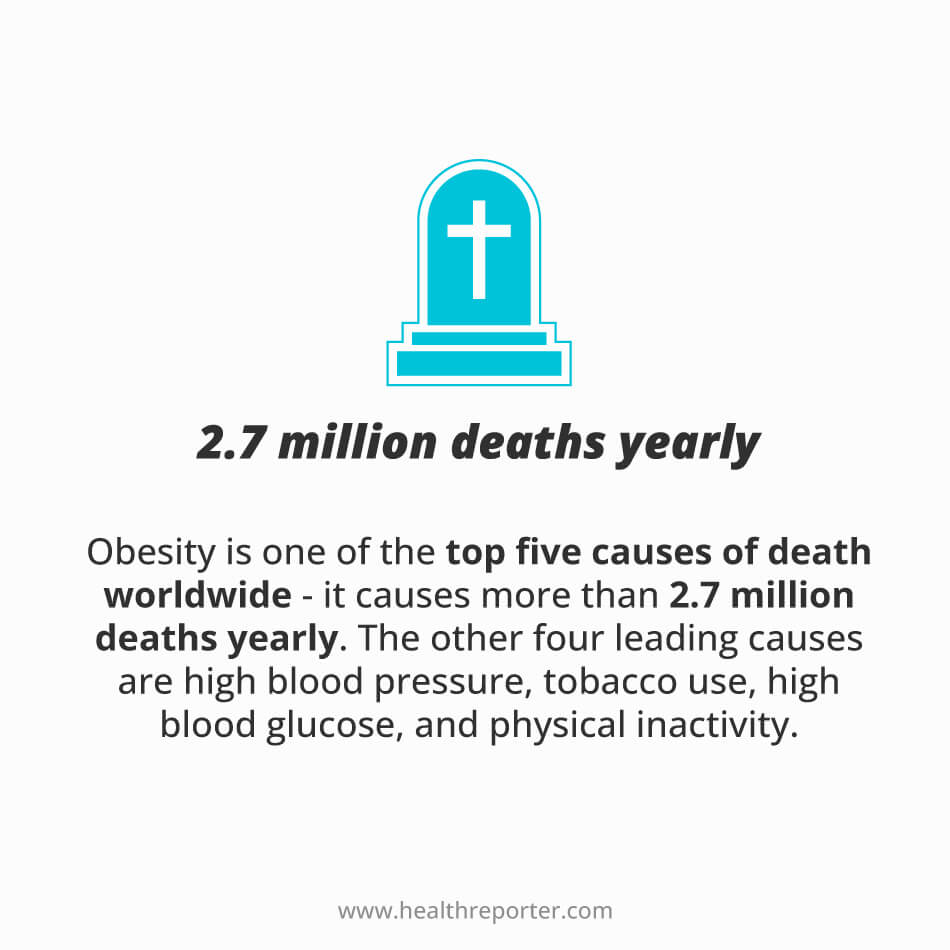
6. Obesity is most common in middle age
Adults between 40 and 59 are more likely to suffer from obesity, with more than 40% of adults between these ranges already suffering. A further one-third of adults aged 60 and over have obesity, and another 32.3% of adults aged 20 to 39 have obesity.
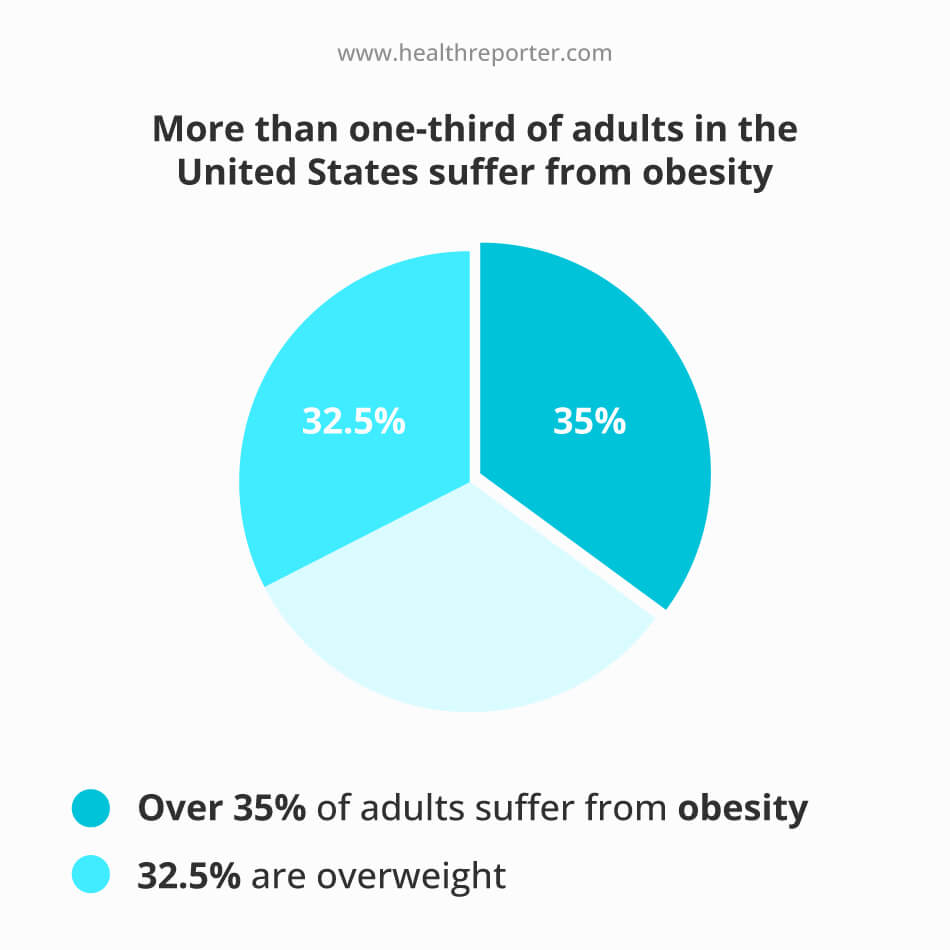

7. Older women are more likely to have obesity than older men
Males are more likely to be overweight than females; however, over 40% of women in the US have obesity.
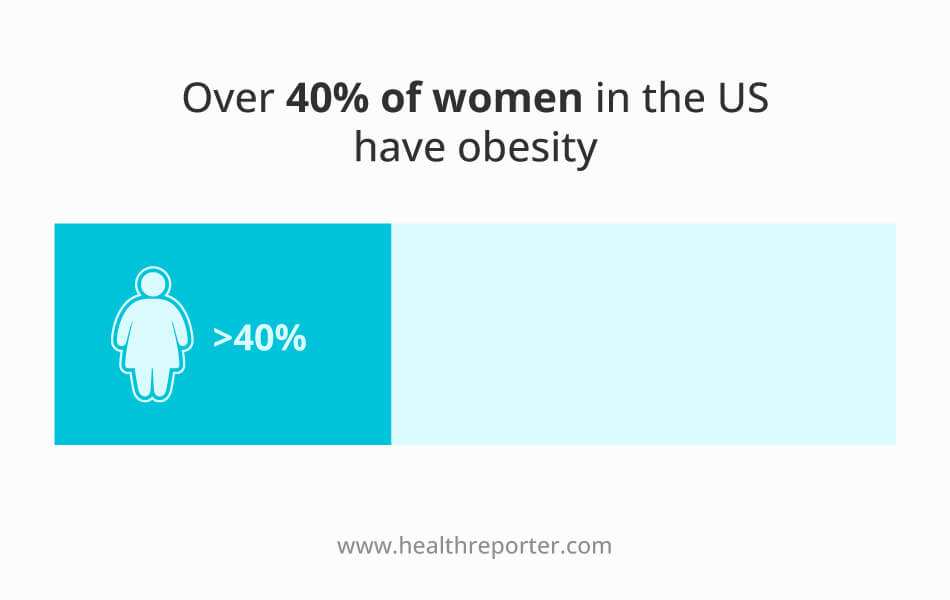
8. All states have obesity rates over 20 percent
Studies show that as of 2017, every state across the US has an obesity rate of over 20% compared to 20 years ago, and no state in the US had an obesity rate of over 15%.
How many people die from obesity in the US?
Obesity and being overweight are the second leading cause of preventable death in the United States, after tobacco use, according to the National Institutes of Health. An estimated 300,000 people die each year from the obesity epidemic.
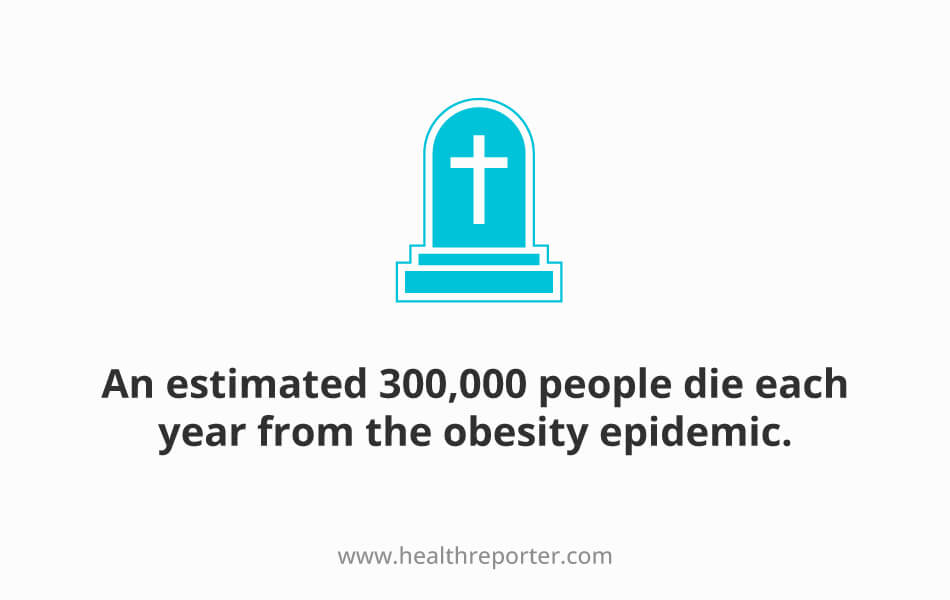
One study found that the annual number of deaths due to obesity varied by cohort used to calculate the hazard ratio (HR), but the overall results were consistent. More than 80% of estimated obesity-related deaths occur in people with a body mass index greater than 30 kg/m2.
When HR estimates were made for all eligible subjects in all six studies, the mean estimate of deaths due to obesity in the United States was 280,184 (range: 236,111-341,153).
Which groups have the highest prevalence of obesity in the US?
Non-Hispanic Black adults had the highest age-adjusted obesity numbers (49%), followed by Hispanic adults (45%), non-Hispanic White adults (41%), and non-Hispanic Asian adults (41%).
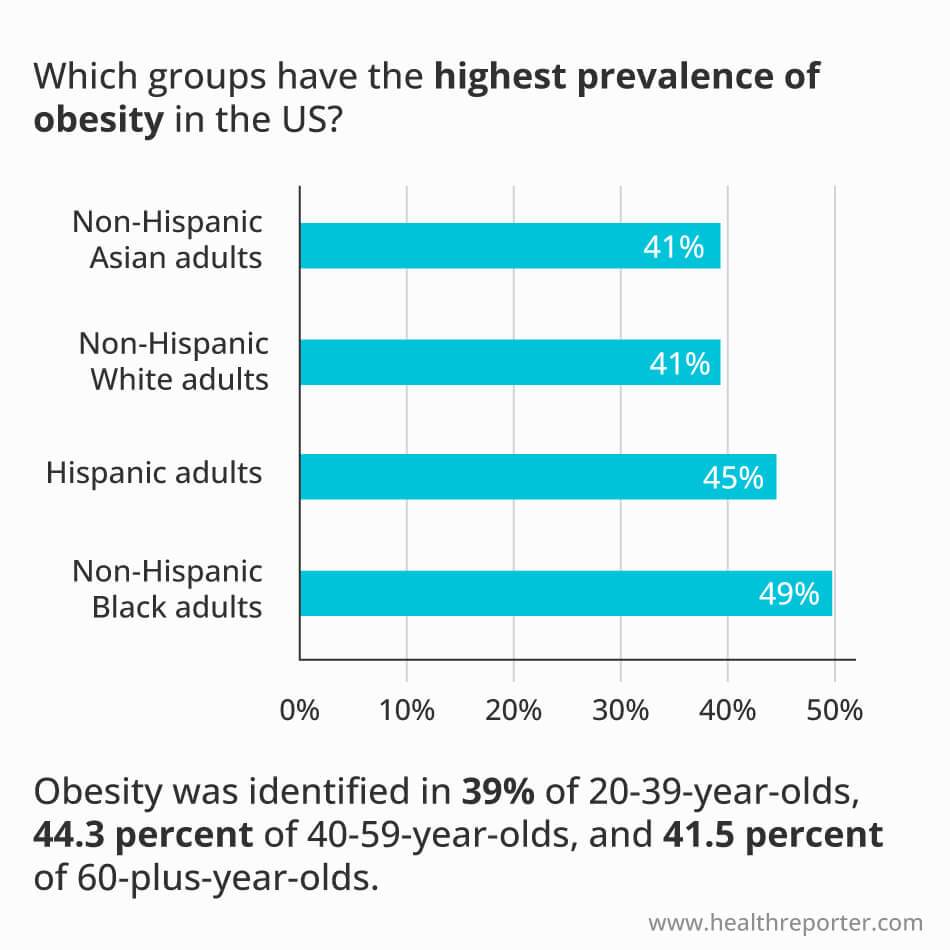
Obesity was identified in 39% of 20-39-year-olds, 44.3 percent of 40-59-year-olds, and 41.5 percent of 60-plus-year-olds.
Men and women with college degrees had a lower chance of obesity when compared to those with lesser education.
Non-Hispanic White, non-Hispanic Black, Hispanic women, and non-Hispanic White males all had the same obesity and education pattern.
Obesity was less common among men in the lowest and highest income categories than in the middle-income group. This pattern was discovered in both non-Hispanic White and Hispanic men. Obesity was more common among non-Hispanic Black men in the highest income group than in the lowest income group.
Which States Are the Most Obese?
In the United States, obesity is considered an epidemic. Obesity is defined as a BMI of 30 or higher in an adult. According to the Centers for Disease Control and Prevention, 39.8% of Americans, or 93 million people, were obese in 2015-2016.
Overeating, lack of physical activity, heredity, culture, and metabolism are all variables that contribute to body weight. Obesity has been related to a variety of health issues and diseases, including premature death, type 2 diabetes, heart disease, some types of cancer, and stroke. As a result, obesity prevalence plays a big role in deciding which states are the healthiest.
Mississippi has the highest obesity percentage, with a rate of 40.8 percent, according to the CDC’s most recent obesity statistics. Mississippi has the shortest life expectancy of any state.
Here are the ten states with the highest rates of obesity:
- Mississippi (40.80%)
- West Virginia (39.70%)
- Arkansas (37.40%)
- Oklahoma (36.80%)
- Kentucky (36.50%)
- Tennessee (36.50%)
- Alabama (36.10%)
- Michigan (36.00%)
- Louisiana (35.90%)
- South Carolina (35.40%)
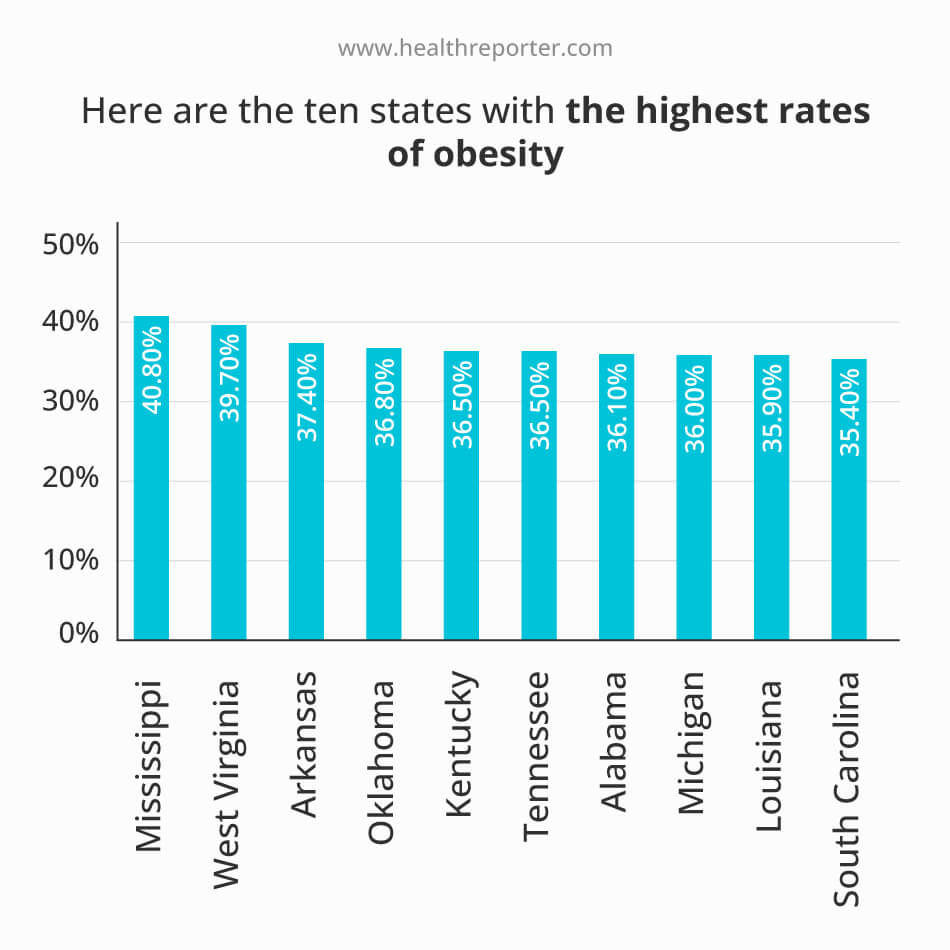
Here are the states with the lowest rates of obesity:
- Colorado (23.8%)
- Hawaii (25%)
- Massachusetts (25.2%)
- California (26.3%)
- Vermont (26.6%)
- Florida (27%)
- New York (27.1%)
- New Jersey (27.3%)
- Washington (28.3%)
- Montana (28.3%)
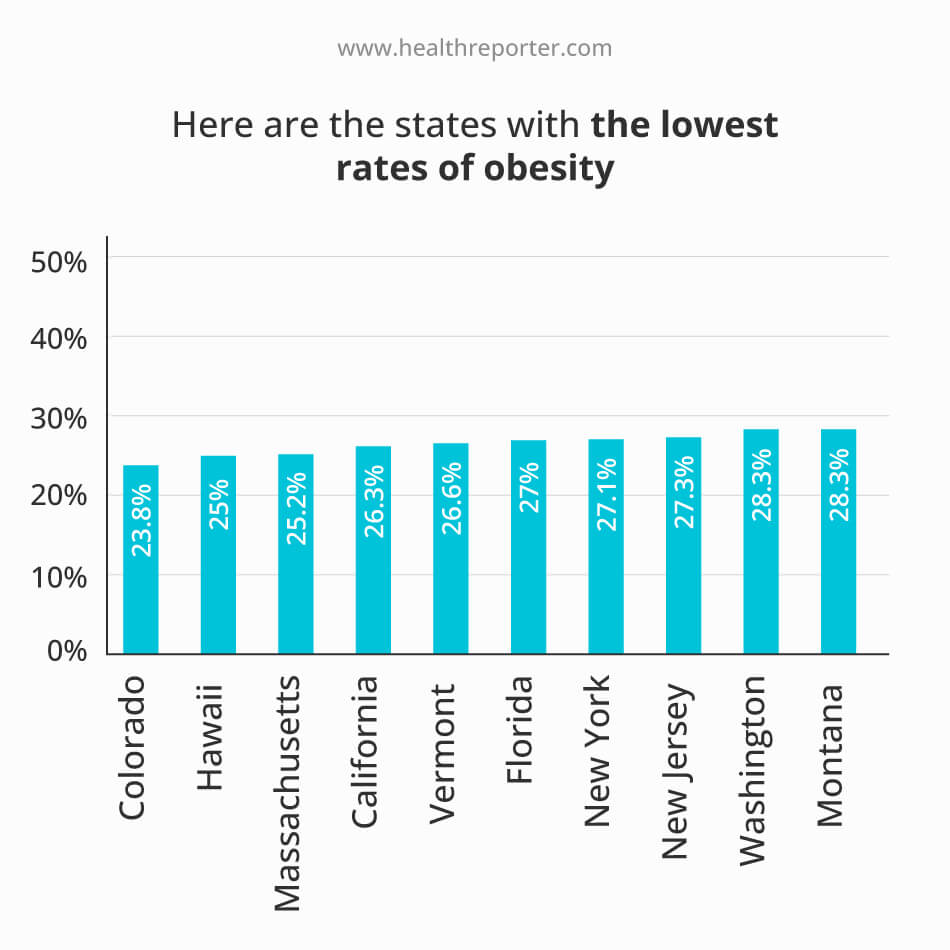
What causes obesity in America?
The numbers and statistics labeled above are quite concerning for US citizens, but it does beg the question – why is obesity in the USA so severe?
Bigger Portions
According to the United States Department of Agriculture (USDA), the average American consumed over 20% more calories in 2000 than in 1983, partly due to an increase in meat consumption. Today, each American saves an average of 195 pounds of beef yearly, up from 138 pounds in the 1950s. Over the same period, added fat consumption increased by nearly two-thirds, while grain consumption increased by 45 percent.
Featured Online Programs
The World Health Organization showed that an increase in fast food sales was linked to the rise in BMI. Americans are infamous for their fast-food consumption, with fast food accounting for around 11% of the average American diet. Another study shows the extent to which additional sugars from soda and energy drinks are wrecking American waistlines. So it’s not only about how much we eat, but also about what we eat.
Confusing “Diet” for “Nutrition”
Diet has a significant, albeit complicated, part in the obesity pandemic in the United States. Consumers are given a jumble of information when it comes to what to eat and how much to eat. Larger amounts, processed packaged food, and drive-thru meals are marketed as almost typically American – quick, inexpensive, satisfying, and delicious.
On the other side, they spend more than $20 billion yearly on weight-loss programs, ranging from diet books and medicines to last-resort operations such as lap bands and liposuction.
Final thoughts
It is evident that America is going through an obesity crisis. The growing rates across all states are alarming; given the low levels of obesity experienced only 20 years ago, it is evident that obesity is becoming a pandemic.
Vast sums of money are being spent to try and counter its rapid growth, but the figures do not lie. More must be done to cull the mortality rate, and the knock-on effect it has on other medical conditions is plunging the USA into a crisis.

















































 Select your language:
Select your language: 








